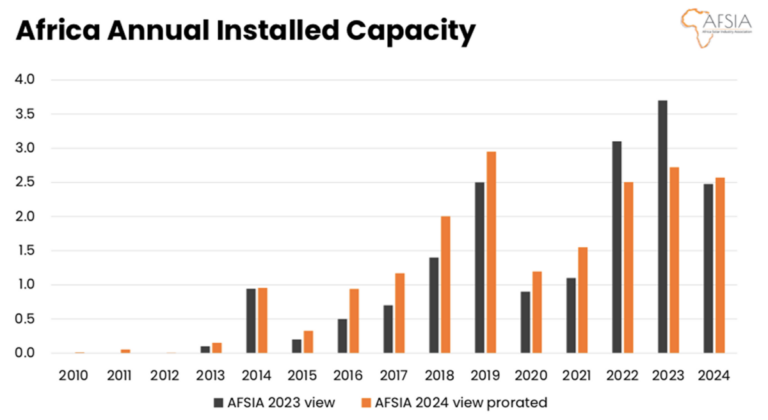The African Solar Industry Association (AFSIA) says utility-scale projects will dominate new solar additions in Africa in 2024, with storage installations increasing tenfold.
Africa will deploy an additional 2.5 GW of solar energy by 2024, according to AFSIA’s new “Africa Solar Outlook 2025” report.
AFSIA’s figures, which exclude residential installations, put the continent’s combined solar capacity at 19.2 GW. According to the report, last year’s new solar additions represented 0.5% of all new global capacity – a level last recorded in 2013.
“Such a low corporate share does not do justice to Africa’s solar potential, nor to the need for new energy generation across the continent,” AFSIA said. “It is hoped that financing flows will evolve in the coming years so that Africa can fully realize its unparalleled solar potential.”
There is optimism that deployment will accelerate in the coming years. 40 GW of new projects were announced in 2024, the report said, representing a 21% increase in the project pipeline compared to 2023.
AFSIA said South Africa and Egypt accounted for about 78% of new PV additions in Africa last year, with South Africa contributing about half and Egypt 28%. However, AFSIA said it expects solar energy distribution to shift in 2025 as construction begins on groundbreaking projects in other countries.
AFSIA also analyzed the percentage of solar energy in each African country’s total energy mix. The Central African Republic is currently leading the way in this area, with solar energy accounting for 43.1% of the country’s energy mix, followed by Mauritania with 20.7% and Namibia with 13.4%. A total of seven African countries have figures above 10%, while 21 currently produce 5% or more of the electricity they consume through solar energy.
Utility-scale PV represented 72% of new solar installations in Africa in 2024, up from 32.4% the year before. In absolute numbers, this translates into 1.78 GW of utility-scale installations in 2024, compared to 521 MW the year before.
AFSIA said utility-scale projects dominated new solar additions in Africa last year, in contrast to the previous two years when the commercial and industrial (C&I) segment led the growth, mainly due to market evolution in South Africa .
The report noted that the C&I market remains strong, with almost 6 GW of captive projects and 1.7 GW of wheeling projects announced in 2024. While most upcoming wheeling projects are in South Africa, AFSIA said the most captive C&I projects are located outside the country.
AFSIA said Africa’s energy storage market was growing rapidly in 2024, with a total installed capacity of 1.64 GWh, a tenfold increase from 157 MWh in 2023. The association said it expects continued growth, with 18 GWh of storage projects that are now under development.
The report states that the expansion of the market will see solar plus storage become the standard for large-scale projects and factory upgrades. Countries such as South Africa, Senegal, Malawi, Botswana, Tanzania, Namibia and Mauritius are pursuing large-scale storage initiatives with a combined capacity of more than 500 MW.
This content is copyrighted and may not be reused. If you would like to collaborate with us and reuse some of our content, please contact: editors@pv-magazine.com.


